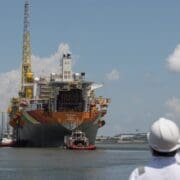Guyana: The Only Country In The Americas Forecast For Double-Digit Growth Through 2027
By NAN Business Editor
News Americas, NEW YORK, NY, Thurs. Oct. 9, 2025: The South American CARICOM nation of Guyana is defying global economic gravity. According to the World Bank’s October 2025 Global Economic Prospects Report on Latin America and the Caribbean, it is the only country in the Americas forecast to record double-digit GDP growth through 2027.
The opening of the new Bharrat Jadgeo Demerara River bridge adds to the growth in Guyana. (DPI Image)
The report projects Guyana’s real GDP growth at 11.8% in 2025, jumping to 22.4% in 2026 and 24.0% in 2027, fueled by an oil and gas boom that continues to transform its economy. No other nation in the hemisphere comes close to those figures.
A Lone Outlier in a Slow-Growth Hemisphere
While Guyana soars, the rest of Latin America and the Caribbean will expand at far slower rates. The World Bank projects the region’s average growth at just 2.3% in 2025, edging up to 2.5% by 2027, restrained by weak investment, high borrowing costs, and sluggish productivity.
The top ten fastest-growing economies for 2025–2027 are as follows:
Rank Country 2025 Forecast (%) 2026 Forecast (%) 2027 Forecast (%) Key Growth Driver 1Guyana11.822.424.0Oil exports, infrastructure, FDI 2Paraguay4.23.73.7Agriculture, hydropower 3Argentina4.64.04.0Energy sector recovery 4Dominican Republic3.04.34.5Tourism, services, investment 5Costa Rica3.63.63.7Tech exports, green economy 6Panama3.94.14.1Logistics, services, canal expansion 7Suriname3.23.43.7Mining, oil projects 8Guatemala3.93.73.7Remittances, construction 9Grenada3.73.32.7Tourism, public investment 10St. Lucia3.92.52.1Tourism rebound
Guyana’s dominance is clear — growing at three to five times the pace of any other country in the region.
The Power Behind Guyana’s Boom
Since 2020, offshore oil discoveries have catapulted Guyana into the ranks of the world’s fastest-expanding economies. ExxonMobil and its consortium partners have already lifted daily output above 600,000 barrels, with projections to exceed one million barrels by decade’s end.
The government’s Natural Resource Fund (NRF) manages oil revenues to support infrastructure, health, education, and renewable energy projects. Massive road and housing programs, along with plans for a new gas-to-energy plant, are laying the groundwork for diversification including the just opened Demerara Harbour Bridge, renamed the Bharrat Jagdeo Demerara River Bridge. The US$262 million engineering feat, Guyana’s longest and most advanced river crossing, now connects both sides of the Demerara River with 24/7 traffic, marking a turning point in national infrastructure. Constructed by China Railway Construction Corporation, the new structure replaces the venerable Demerara Harbour Bridge with four vehicle lanes, pedestrian and cyclist paths, and unrestricted river passage for ships. With foundations anchored by 658 piles, it is now the nation’s strongest bridge.
Economists warn, however, that sustaining momentum requires strong governance, transparent spending, and investment in human capital.
World Bank: Reforms Needed for “Transformational” Entrepreneurship
Beyond oil, the report calls for domestic reforms to attract investment and promote “transformational” entrepreneurship — high-growth firms that diffuse technology, create jobs, and raise productivity.
“The entrepreneur is the critical actor in development, identifying opportunities, innovating, and taking the risks needed to create value added and jobs,” said William Maloney, Chief Economist for Latin America and the Caribbean at the World Bank. “Creating more dynamic economies in Latin America and the Caribbean will require strengthening our pipeline of entrepreneurial talent, while undertaking the systemic reforms necessary for them to thrive.”
Despite enthusiasm for entrepreneurship, most firms in the region are micro or small enterprises with limited paths to scale — representing up to 70% of businesses in some countries. The Bank argues that a smaller group of high-growth, innovative firms could drive productivity and innovation but face familiar barriers: scarce financing, burdensome regulation, skills shortages, and weak infrastructure.
To foster private-sector-led growth, the report proposes a three-point reform agenda:
Invest in Human Capital – Improve education at all levels, expand managerial training, and align workforce programs with private-sector needs to fuel job creation.
Reform Business Regulation – Remove distortionary subsidies, modernize tax policy, and upgrade logistics, energy, and digital systems to reduce entry barriers.
Expand Access to Finance – With a quarter of firms credit-constrained, the Bank urges stronger risk-sharing, streamlined dispute resolution, and modern bankruptcy laws to support both lenders and entrepreneurs.
The Road Ahead
The World Bank warns that without reforms, much of the region risks stagnation. Yet, with the right mix of fiscal prudence, institutional reform, and inclusive entrepreneurship, Latin America and the Caribbean could reignite growth and competitiveness.
In that effort, Guyana’s success story — balancing oil wealth with long-term investment — may serve as both an inspiration and a cautionary tale for its neighbors.









Leave a Reply
Want to join the discussion?Feel free to contribute!